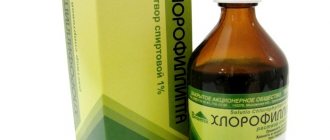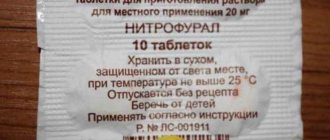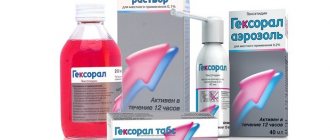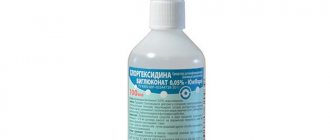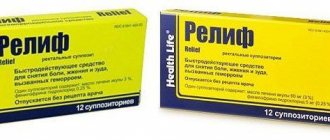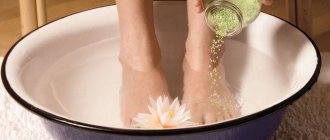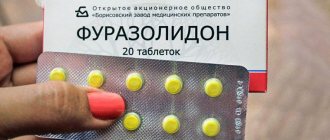Iodinol is a fairly popular medicine for throat diseases, which produces a powerful anti-inflammatory effect and at the same time has a low price. Its second name is blue iodine. The medicine began to be widely used to treat inflammatory processes in the nasopharynx and throat back in the 40s of the 20th century. The basis of the medicine is iodine, but in it it is much safer due to its combination with other components and does not cause severe effects on the body. Iodinol effectively eliminates inflammation and purulent processes, as it has a detrimental effect on their provocateurs, which are:
- streptococci;
- staphylococci;
- gram-negative bacteria;
- gram-positive bacteria;
- Pseudomonas aeruginosa;
- coli;
- pathogenic fungi;
- yeast mushrooms.
This antiseptic is almost universal and therefore is used not only to treat mucous membranes, but also to treat trophic ulcers, burns and extensive skin damage.
Iodinol solution is approved for use in children, which is very important due to the fact that they most often suffer from throat diseases.
Description of the drug Iodinol
Local antiseptic "Iodinol" is used in case of various inflammations of the skin, as well as dysfunction of the inner lining of hollow organs. The drug is widely used in the treatment of inflamed tonsils, acute disease of the middle or inner ear with purulent discharge, and prolonged rhinitis.
The drug is used as an additional medication in the treatment of chronic tonsillitis, stomatitis and conjunctivitis. The medication is famous for its particularly fast results in the treatment of trophic ulcers, burns and wounds.
This drug is used to wash the tonsils and clear the sore throat covered with purulent plaque.
"Iodinol" acts as an adjuvant in the treatment of acute respiratory diseases, as well as chronic or acute sinusitis. There is a practice of treating cystic fibrosis with an antiseptic.
The drug is produced in the form of solutions of 100 or 200 ml. The drug consists of an aqueous solution of iodine and potassium iodide, as well as polyvinyl alcohol. The drug should be dissolved in water.
The combination of the main components allows the substance to be used as a powerful anti-inflammatory drug, but the main effect of Iodinol is antiseptic.
pharmachologic effect
Iodine-containing agent with antiseptic effect. The main active ingredient is molecular iodine, which has antiseptic properties. When applied to large surfaces of the skin, iodine, which is part of Iodinol, has a resorptive effect: it actively affects metabolism, enhances dissimilation processes, participates in the synthesis of T3 and T4, and has a proteolytic effect. Ethanol slows down the excretion of iodine and reduces its irritating effect on tissue.
It has a bactericidal effect on gram-positive and gram-negative flora (most active on streptococcal flora and Escherichia coli, Proteus), as well as on pathogenic fungi and yeast. Causes the death of spores of the causative agent of anthrax (at a concentration of 1% free iodine for 30 minutes). A more resistant flora is staphylococcus, however, with long-term use of the drug, suppression of the staphylococcal flora is observed in 80% of cases. Pseudomonas aeruginosa is resistant.
The drug is low toxic.
For children
Due to its good antiseptic properties, iodine has found application not only for external treatment of the skin, but also for the treatment of infectious lesions of the mucous membranes. Well-known iodine-based preparations - Lugol, Yox - are available in the form of solutions and sprays.
A similar medicine is Iodinol, instructions for use for gargling are the subject of consideration in this article.
The composition of Iodinol (100 ml) includes:
- iodine (0.1 g);
- potassium iodide (0.3 g);
- polyvinyl alcohol (0.9 g);
- water (up to 100 ml).
The drug has a characteristic odor of iodine and a dark blue color, which is why it received the unofficial name “blue iodine”. When shaken, the solution foams.
Iodinol is sold in pharmacies in bottles of various sizes from 25 ml to 250 ml, glass and plastic. For hospitals, the drug is produced in bottles up to 5 liters.
The drug for individual use is available in several forms:
- with a stick-tassel;
- with a spray nozzle;
- in bottles without additional accessories.
Depending on the configuration of the bottle and therapeutic objectives, the solution can be used in 3 ways:
- lubrication;
- spraying;
- rinsing.
Instructions for use of Iodinol do not require rinsing. However, such a practice of using this drug exists.
How to gargle with Iodinol:
- The drug is measured using a measuring cup (not supplied) or using a tablespoon.
- If there is no measuring cup, measure 1 tablespoon of the drug into a glass.
- Add 100-200 ml of warm water to the glass.
- Next, gargle with the resulting solution for 1-2 minutes.
Iodinol is produced by several Russian pharmaceutical factories. But they all warn that the drug should not be given to children until at least 6 years of age. For bottles that are not equipped with a stick, brush or spray, the instructions for use of Iodinol note that before the age of 18, the solution should be used with caution.
The restriction on the use of gargling solution in children is due to the fact that, firstly, the child must be able to gargle and, secondly, must understand that the medicine cannot be swallowed.
If these conditions are met, there is no reason not to use Iodinol for children. Moreover, iodine is an essential element for the development of a child’s body.
When swallowing 15 ml of the drug (1 tablespoon), 15 mg of iodine and 45 mg of potassium salt of hydroiodic acid enter the body. As a result, the child will develop symptoms of so-called “iodism”: swelling of the mucous membranes, increased salivation, skin rashes. Iodine poisoning is also possible, characterized by the following symptoms:
- overexcitement;
- irritability;
- increased heart rate;
- sleep disturbance;
- nausea, vomiting, abdominal pain and other dyspeptic symptoms.
By using Iodinol according to the instructions, all these side effects can be avoided.
The antimicrobial activity of the drug with the simultaneous absence of pharmacological negative effects makes Iodinol an optimal remedy for the treatment of the throat and oral mucosa in children.
A significant advantage of the drug is its good tolerability and lack of irritation at the site of application.
The children's dosage of Iodinol for gargling is no different from that for adults.
Children who do not yet know how to rinse should use the drug by lubricating it with the included brush or cotton swab (cotton swab).
The instructions for use of Iodinol indicate that the use of the drug is contraindicated during pregnancy and lactation.
Iodine penetrates the placenta and is also deposited in the mammary glands. Gargling with Iodinol should not be done, because
with this form of application, the solution comes into contact with a large area of the mucosa, which ensures active absorption of iodine from the drug.
An alternative option is recommended - lubrication with a brush or spraying with a spray - in these forms, doctors prescribe this drug both for pregnant women and during breastfeeding. Additional iodine is useful during these periods.
The manufacturer in the instructions for use of Iodinol does not specify how to use the rinse solution: whether it needs to be diluted and in what proportion this should be done.
Since there are no exact instructions on diluting the drug, you can focus on a ratio of 1:7 to 1:14 - i.e. dilute 1 tablespoon of solution in 100-200 ml of water. During the treatment process, you will be able to settle on the concentration that seems more suitable to you.
Follow the instructions for using Iodinol:
- Measure the required amount of solution into a glass and mix with water as shown above.
- Pour the contents of the glass into your mouth.
- Tilt your head back and look up.
- Inhale through your nose.
- Open your mouth slightly.
- Make a long vowel sound “A” or simply exhale through your mouth SLOWLY.
- Repeat steps 4-6 several times so that rinsing takes 1-2 minutes in total.
- Spit out the solution.
How to lubricate
In accordance with the instructions for use, Iodinol for lubrication does not require additional dilution. The drug is applied using a brush or cotton swab (on tweezers, on a pencil). You can use a cotton swab. Follow the following algorithm:
- Pour a small amount of the drug into a separate container (lid, small tray, etc.).
- Dip the brush (swab, cotton swab) into the container with the drug.
- Treat the desired area as many times as necessary.
- The remaining solution should be discarded.
In the same way, Iodinol is used to lubricate the tonsils of a child with a sore throat. The procedure is not the most pleasant. However, when done carefully, it is well tolerated by children.
The drug is indicated as an antiseptic for external and local use:
- for sore throats;
- for infectious inflammation of the oral mucosa;
- for the prevention of infectious inflammation of the oral mucosa;
- for otitis;
- for treating skin ulcerations;
- for the treatment of burn injuries.
Iodinol for sore throat
Instructions for use of Iodinol recommend using the drug in the form of rinses. The procedure is carried out by ENT doctors using a syringe with a special nozzle.
At home, patients with tonsillitis can lubricate the tonsils with a cotton swab or brush. Rinse is applicable. However, due to the fact that it is carried out with a dilute solution, this procedure is less effective than lubrication.
In addition, for sore throat, it is appropriate to spray the product directly onto the tonsils.
Treatment with Iodinol for angina should be carried out 3-4 times a day.
It must be borne in mind that the presence of pus or blood weakens the antiseptic effect of iodine. Therefore, if there is pus on the tonsils, you should first cleanse them of impurities.
Iodinol for angina in both children and adults should be used as part of complex therapy under the supervision of a physician.
Despite the fact that the drug does not have an analgesic effect, its use is justified for bacterial pharyngitis. It allows you to effectively fight germs. Suppresses, among other things, staphylococci and fungal infections.
The most convenient way to use for stomatitis is lubrication. Using a tampon or brush, it is possible to apply the drug pointwise, directly to the inflamed areas. Iodinol is often prescribed for stomatitis in children.
The drug is contraindicated:
- with an allergic reaction to iodine;
- with thyrotoxicosis;
- during pregnancy and lactation (in the form of rinsing);
Possible side effects:
- allergic reactions;
- increased salivation;
- swelling of the mucous membrane;
- runny nose.
Iodinol spray
Iodinol can be purchased at the pharmacy not only in the form of a solution for rinsing and treating mucous membranes, but also in the form of a spray. In this case, the bottle is equipped with a spray nozzle.
The advantage of the spray is obvious: it is convenient to spray it into the throat on the desired areas. This is important considering that iodine leaves traces on hands, clothes and objects on which the drug can accidentally come into contact with the solution (dilute, rinse, apply).
When buying Iodinol, ask the seller if the bottle has a spray nozzle for using it as a spray.
Iodine as an antiseptic is included in such drugs as Lugol and Yox. Both are produced at Russian pharmaceutical factories.
Yox-spray, which is based on an aqueous-alcoholic solution of a complex of iodine and povidone. The advantage of this drug is the slower release of iodine from the complex and, accordingly, a longer antiseptic effect.
Lugol - in the form of a spray and solution - a mixture of glycerin and iodine. The enveloping effect of glycerin also contributes to a longer lasting effect.
Iodinol is the cheapest of the listed iodine-containing drugs.
Let us highlight the main characteristics of Lugol and Iodinol:
- Both drugs contain iodine in the same concentration.
- Iodinol is tasteless and usually does not sting.
- Lugol is more aggressive and often causes irritation.
- Lugol's is not used for rinsing.
Judging by the reviews, the therapeutic effectiveness of both drugs is high, approximately the same.
Patients give good feedback on the use of the drug in both adults and children.
Among the advantages of the solution are:
- efficiency;
- affordable price;
- good tolerance.
There are no negative aspects of using Iodinol in the reviews.
Dentists prescribe Iodinol for stomatitis, as well as for teething in children. It is recommended to apply the drug to areas of the mucous membrane using a brush or swab. Mothers who used the medicine in such cases noted in their reviews the effectiveness of the treatment, as well as the good tolerance of the procedure by their children.
When used in children, it should be borne in mind that the drug leaves permanent marks on clothing and other objects. Do not leave a bottle of medicine or a container of diluted medicine within a child's reach.
You can see how to prepare blue iodine (this is the unofficial name for iodinol) yourself in the following video.
Conclusion
The obvious advantages of the drug - affordable price and antiseptic effectiveness - make the drug in demand by Russian patients.
Indications for use of Iodinol
Patients who want to learn how to gargle with Iodinol should understand for what diseases this medicine is indicated for use.
Externally:
- Abrasions, scratches, wounds, injuries.
- Various skin lesions of an infectious and inflammatory nature.
- Myalgia.
Local:
- Acute and chronic tonsillitis.
- Otitis of a purulent nature.
- Atrophic rhinitis.
- Thermal and chemical burns of 1st and 2nd degree.
- Infected burns.
- Inflamed wounds.
- Varicose and trophic ulcers.
Inside:
- Prevention and treatment of atherosclerosis.
- Some diseases of the gastrointestinal tract.
- Tertiary syphilis.
It should be noted that the prescription for treatment with Iodinol must be made by a doctor, especially when taking the drug orally and its use in patients with a number of serious chronic diseases.
Iodinol during pregnancy
The drug, according to the instructions for use, has contraindications for pregnancy and breastfeeding, so use during these periods is not recommended. In cases where the benefits of use outweigh the potential harm to the health of the expectant mother and child, the doctor may prescribe Iodinol. It is important to follow the prescribed dosage and avoid ingestion.
Due to the ability of iodine particles to penetrate placental tissue, special care must be taken during use. In addition, iodine can accumulate in mammary gland tissue.
Therefore, during pregnancy and lactation, using the drug as a rinse is contraindicated.
But you can lubricate your throat. This method is not dangerous for the woman and the fetus. If there is a lack of iodine in the body, a positive effect even develops.
Directions for use and dosage
Iodinol is used externally for antiseptic treatment of damaged areas of the skin. Oral use and dosage are prescribed strictly by the attending physician. Topically used for:
- washing the lacunae of the tonsils and supratonsillar space - every 4 hours, taking breaks, for 2-3 days;
- treatment of otitis: instill 5-8 drops into each ear for 2 weeks - 1 month;
- irrigation of the nose and pharynx for atrophic rhinitis: every 2-3 days for 2-3 months (preliminary softening of the crusts is necessary and their subsequent removal);
- daily lubrication of the tonsils for chronic tonsillitis;
- impregnation of gauze pads used in the treatment of varicose and trophic ulcers - after preliminary washing of the affected areas, apply zinc ointment around them, then apply a bandage with Iodinol on top for 3-5 days (the solution is added periodically);
- wetting gauze bandages (renewed as necessary) applied to burn areas and purulent wounds;
- preparing a solution for douching for thrush.
Iodinol for sore throat
There are only 2 options for using the drug in question - gargling and treating the tonsils with a clean solution. The use of Iodinol for sore throat helps achieve the following results:
- elimination of gram-negative and gram-positive bacteria;
- fight against yeast fungi;
- mild pain relief;
- relief of the inflammatory process;
- washing out pus from lacunae and caseous plugs;
- relieving redness and swelling.
Iodinol is especially effective for purulent pharyngitis as a local antiseptic. Otolaryngologists even use it for outpatient cleansing of lacunae from caseous plugs. At home, it is recommended to gently treat the tonsils with a cotton swab dipped in the preparation 2-3 times a day for 5 days. Within 48 hours from the start of such treatment, the amount of pus in the lacunae decreases and the intensity of the pain syndrome decreases. If excessive burning and discomfort is felt during treatment, you can slightly dilute the medicine with clean water.
Iodinol for gargling - preparing a solution
Before use, the medicine must be diluted in water, observing the dosage, since rinsing your mouth with Iodinol in its pure form is prohibited due to the high risk of burns.
How to dilute Iodinol correctly:
- Take warm clean water (200 ml) into a glass;
- take the pipette;
- prepare a bottle of Iodinol;
- draw the antiseptic into the pipette;
- Add blue iodine drop by drop to the water until it turns a light yellow color.
After this, you can begin the rinsing procedure. If you don’t have a pipette on hand or have time to dilute the drug drop by drop, you can prepare a solution in the following proportions: 1 tablespoon of antiseptic per 1 glass of water.
Is the medication allowed during pregnancy and lactation?
Instructions for use of Iodinol for children have a number of limitations.
It is not advisable to use the drug in patients under 6 years of age.
If a dispenser or sprayer is not available, special care must be taken until the age of 18.
That is, children usually do not gargle with Iodinol. Since there is a high risk of accidental ingestion of the solution. Which is highly undesirable.
However, children can use Iodinol spray. It is allowed to lubricate the tonsils with this drug.
Gargling with iodine
One of the therapeutic procedures in which iodinol is used is gargling. This procedure perfectly helps to cope with such ailments as purulent tonsillitis and chronic tonsillitis. To do this, iodinol is gradually added to a glass of warm water. Gargling begins when the solution turns dark yellow. For severe pain, the procedure is performed every 4 hours, and then 3 times a day. Some doctors suggest not gargling with iodine, but lubricating it. As practice shows, this method of treating a throat with iodinol is no less effective. In this case, iodinol is not diluted in water. A cotton swab wrapped around the tip of a long stick is dipped in the medicine and lubricated with it on the tonsils. For purulent tonsillitis, lubricating the throat with iodine is carried out 2-3 times a day, and for chronic tonsillitis - once. Both when lubricating and when gargling with iodinol, the course of treatment is 3-5 days.
Special instructions on how to gargle with Iodinol:
- Although the product is of low toxicity, it can cause pain and irritation of the mucous membranes of the mouth and throat. This should be taken into account when using Iodinol for tonsillitis, stomatitis and pharyngitis.
- Iodinol should not be taken orally, as there is a risk of burning the esophagus.
- Otolaryngologists use 50 ml of Iodinol to rinse the lacunae of the tonsils and the adjacent (peritonsillar) space. 4 procedures are enough, with a two-day interval between them. Dosage is given for adults.
- For stomatitis, blue iodine is diluted with water in a ratio of 1 to 2, the solution is applied to a gauze swab and applied to the affected areas of the gums or mucous membrane for a few seconds. Then you need to rinse your mouth.
How to use the spray correctly
The drug in this dosage form is very convenient to use. In addition, its advantage is that the required therapeutic dose of medication is immediately administered, which is very important. It is used both to treat the affected dermis and for sore throat. Iodinol spray is a good alternative to gargling. Before the injection procedure, the tonsils are cleaned with a soda solution or plain water by rinsing. Next you need to do the following:
- Remove the cap from the bottle and install the spray nozzle.
- To draw the medicine into the nebulizer, press the nozzle twice.
- Insert it into the oral cavity about two centimeters, hold your breath and turn it slightly to the left. Make one injection, then turn to the right and also release the drug.
- After the procedure, remove the spray nozzle and rinse with warm water.
Adults are allowed to repeat spraying up to four times a day, children - from two to three.
Use of iodinol in folk medicine
Traditional medicine has many recipes for preparing medications based on blue iodine. Here are some of them.
Eye diseases. Usually, to eliminate styes, redness and other eye aggravations, they use lotions made from brewing black or green tea, but these remedies have different healing properties than iodinol. Starch in combination with iodine penetrates deeper into the eye socket and treats it more efficiently. It even heals scratches in the cornea of the eye, as well as conjunctivitis. Take 1 teaspoon of iodinol and dilute it in 10 teaspoons of distilled water. The first time, drip two or three drops of the solution into your eyes - onto the lower eyelid. If there is no reaction, repeat the procedure in the evening. In the morning, open your eyes freely - conjunctivitis is gone, there is also no suppuration and no traces of inflammation.
Colitis. Add cherry or some other berry or fruit syrup to blue iodine to taste. During attacks, take teaspoons of iodine, regardless of the dose. At the beginning of treatment, vomiting may occur, do not be afraid of this. Drink blue iodine until the pain subsides and the vomiting stops. If an attack of colitis began to be treated in the evening, then before the morning you should drink at least a glass of iodinol (daily norm). In the future, treatment can be continued until the disease subsides completely.
Stomach upsets. The famous Russian healer V. Travinka treats this ailment with a combination of blue iodine and blue healing clay. Pre-prepare clay water (1-1.5 tablespoons of clay per glass of water) and give this solution to drink an hour before taking blue iodine. Clay has the excellent property of drawing out waste and toxins from the body, and iodine disinfects and neutralizes the body from harmful microbes.
Burns. Pour blue iodine into a plastic bottle of any container with a thread and through a spray bottle - to spare the wound, spray the medicine over the burned area. Burns can be treated this way. Place a triple layer of gauze moistened with iodine on the burned area. As the compress dries, moisten the gauze again without letting it dry. Soak until the burn is healed. Constant wet lotions prevent the gauze from drying to the wound, numb it, and it does not fester.
How to dilute the preparation for rinsing
There are a number of general principles according to which Iodinol is diluted for gargling. In some cases, general recommendations are neglected in accordance with the advice of a doctor or one’s own negative feelings received from the rinsing process.
Before rinsing, it is recommended to follow a number of simple rules that will help achieve the optimal concentration of the solution so as not to injure the mucous membrane. For example, Iodinol is diluted in water at the ratio of one tablespoon of solution per 250 ml of water.
Some doctors recommend not immediately diluting a tablespoon of medicine in water, but dripping the solution gradually until the water turns light yellow. It is believed that this is easier to protect the oral mucosa from burns by iodine in high concentrations.
It is important to remember that if the solution causes an unpleasant burning sensation, you should add more plain water to it. The emerging burning sensation, first of all, indicates that a person is trying to use an overly concentrated solution, which injures the oral mucosa.
Patients should also remember that Iodinol is always used separately from other drugs that have bactericidal properties. The medicine must not come into contact with drugs that are similar in action but contain alkalis, enzymes or reducing agents.
To treat an adult, Iodinol can be used in three main ways: it can be used to lubricate problem areas, rinse or spray the contents of the bottle.
In general, it is worth keeping in mind that the instructions for the product do not provide information that it can be used for rinsing. However, this practice is widespread, and the drug is successfully used for these purposes.
The scheme for using Iodinol for rinsing in the treatment of adult patients is very simple:
- 200-250 ml of warm water is poured into a glass (it is advisable to use boiled water that has cooled to a comfortable temperature);
- 1 tablespoon of Iodinol solution is added to the glass;
- the resulting solution is mixed thoroughly;
- rinsing is carried out 2-4 times a day, depending on the severity of symptoms.
Iodinol is used very carefully in children. Today, in all instructions for this drug you can find a warning that it is not recommended for use by children who have not yet reached the age of 6 years. In some cases, you can find a warning about careful use of the medicine in the treatment of children under 18 years of age.
Such restrictions were introduced by manufacturers for a reason. For successful treatment, a child must have certain skills: the ability to gargle and the ability to understand that the drug is not intended to be swallowed (for these reasons, infants are excluded, as are babies who cannot yet fully control their actions and understand speech addressed to them) . If the child is understanding and has already been trained in the rinsing procedure, then Iodinol can be used for treatment.
Many adults worry about whether iodine entering through the mucous membrane will be harmful to the child’s body. Vigilant mothers can be reassured: the element is not absorbed through the mucous membrane in such quantities as to provoke some kind of negative effect.
A problem may arise if the solution is swallowed in large quantities (to avoid this, children are not treated with Iodinol until they reach a certain age). If a large amount of iodine enters the body, symptoms will develop, which are commonly called iodism:
- mucous membranes will swell,
- saliva production will increase,
- a skin rash will appear.
If you use Iodinol in accordance with the instructions, then iodism can be easily avoided. Ease of use, subject to basic precautions, has long made Iodinol one of the drugs that are actively used in the treatment of children and adolescents. The drug is generally well tolerated if the patient is not allergic to its components.
To gargle for children, the medicine is diluted in the same ratio as for adults. If your baby has not yet learned how to rinse, you can lubricate the mucous membrane using a special brush.
It is important to remember that pregnancy and lactation are strict contraindications for the use of Iodinol. This is due to the fact that the drug not only easily penetrates the placenta into the embryo’s body, but can also accumulate in milk and enter the baby’s body.
It is not prohibited to use the product externally to treat wounds, but rinsing on wounds is strictly prohibited. This is due to the larger absorption surface compared to application to open areas of the skin.
Interestingly, spraying the drug onto the mucous membranes or lubricating them with a brush is not prohibited. A doctor may prescribe the use of the drug to pregnant and lactating women in these forms, and then there is no reason to fear for the baby’s health.
The process of gargling is not particularly difficult. All you need to do is follow these simple instructions:
- The required amount of Iodinol is dissolved in warm water (the water temperature should be comfortable for rinsing).
- Take a small amount of liquid from a glass into your mouth (if a strong burning sensation or other pain occurs, you need to spit out the liquid and add more water to the glass).
- The head is tilted back so that you can clearly see the ceiling.
- Take a slow breath through your nose, opening your mouth slightly and, for convenience, closing it loosely with your palm.
- Exhale slowly, imagining that they are pronouncing the vowel sound “A” or “O”.
- Spit the solution into the sink.
Rinsing on average should take 1.5-2 minutes. After each spitting of the solution into the sink, a new portion of liquid is drawn into the mouth.
How to gargle for a sore throat (salt, soda or iodine)
There are quite a few analogues for Iodinol. So, for example, iodine is included in the composition of Lugol or Yox in the same concentration, and the dissolving agents themselves have similar properties. All drugs are produced both by a number of Russian manufacturers and by some foreign pharmaceutical companies, so the choice is very extensive.
Yox is mainly available in spray form. Its composition is somewhat different from Iodinol in terms of excipients. For example, iodine from this medicine is not released as quickly as from Iodinol. This is due to its longer bactericidal effect at the site of application.
Lugol's is a mixture consisting of iodine and glycerin. This drug is also believed to have a longer lasting antibacterial effect. Lugol additionally has enveloping properties that protect the mucous membranes from additional trauma. It is believed that this medication has a more aggressive effect, and therefore often causes irritation of the oral mucosa. It is important to remember that Lugol is used less frequently for rinsing, and its concentration is selected individually by the doctor.
Iodinol, although it is the cheapest analogue product, also has a number of advantages. For example, the solution is odorless, making it easier and more pleasant to use for rinsing. An additional advantage is the price of the drug (it fluctuates around 50-70 rubles).
Iodinol is a good remedy for gargling in case of various diseases. The drug is effective, affordable and does not cause negative side effects if used in accordance with the instructions. The medication can be used to treat not only adults, but also children, which gives it an additional advantage.
Iodinol is a drug that will help in the fight against sore throat and other bacterial infections. If a patient experiences a negative reaction to the drug, it is recommended to stop using it and consult a doctor. Although Iodinol rarely causes allergies, the possibility of its development should never be ruled out.
As with any drug, it is recommended that you consult a physician before using Iodinol. If the doctor has not given permission to use the medication, it is better to listen to his advice and choose another medicine that will be more effective and approved by a specialist.
And a little about secrets...
If you or your child are often sick and are treated with antibiotics alone, know that you are only treating the effect, not the cause.
So you simply “spare” money to pharmacies and pharmaceutical companies and get sick more often.
STOP! Stop feeding unknown people!!! You just need to boost your immunity and you will forget what it’s like to be sick!
There is a way for this! Confirmed by E. Malysheva, A. Myasnikov and our readers! ...
It is known that if a child swallows 15 or more ml of Iodinol solution, he may develop “iodism”. The condition is accompanied by swelling of the mucous membranes, increased salivation and rashes on the skin.
For many parents, this information is terribly scary. But it's not all that bad. After all, you need to understand that we mean 15 ml of Iodinol itself, and not a rinse solution. That is, in order to be poisoned, a child must drink 3 teaspoons of the drug.
To prepare the rinse, you need to dilute Iodinol at least 20 times - take 1 teaspoon per 100, or even 200 ml of water.
Therefore, swallowing one sip of the mixture for rinsing is fraught with the entry into the body of a negligible amount of the drug. This is not advisable. But there is no reason to panic.
Contraindications
The drug Iodinol is not recommended for use in the following conditions and diseases: hypersensitivity to the active substance, auxiliary components of the drug; thyrotoxicosis; dermatitis herpetiformis.
Side effects
During the use of the drug Iodinol, it is possible to develop undesirable effects in the form of allergic reactions (irritation, redness, skin itching, swelling, anaphylactoid and anaphylactic type reactions). With prolonged use of the drug Iodinol, the development of iodism phenomena is possible, which can manifest itself in the form of rhinitis, laryngitis, tracheitis, bronchitis, conjunctivitis, lacrimation and increased salivation, rhinorrhea, bronchorrhea, digestive disorders, skin rashes. In individuals who are particularly sensitive to iodine, these symptoms are accompanied by malaise and fever. There may be a metallic taste in the mouth.
Analogs
There is no drug that is 100% similar in composition to Iodinol. Similar in pharmacological action are:
- iodine as a wound-healing agent with antiseptic properties;
- Lugol - for the treatment of stomatitis and throat diseases;
- boric acid – for otitis;
- Vitaon - used to treat sore throat, burns, respiratory diseases, skin damage, etc.;
- Doxycycline is an antibiotic used to treat upper respiratory tract diseases;
- Yoddicerin is a broad-spectrum antiseptic.
Similar antiseptics are Lugol's solution or Yox. Both are made in Russia.
- Yox can be purchased in spray form. It is based on a water-alcohol solution, which includes iodine and povidone. It is distinguished by a slow period of release of iodine particles from the complex base, which creates the advantage of a longer antiseptic effect.
- Lugol is presented on the pharmaceutical market in the form of several dosage forms, including a lubricating solution and a spray. The composition of the drug is iodine and glycerin. Due to the presence of glycerin, an enveloping effect is provided, which helps to achieve a longer action and soften the mucous membrane. Rinsing the mouth with Lugol's solution is not recommended.
The advantages of Iodinol are its low cost, neutral taste and good tolerance by most patients. It can also be used for rinsing.
Do not forget!
Iodinol for sore throat in children and adults should be used only during treatment with antibacterial drugs. By itself, without antibiotics, this medication is not able to eliminate a bacterial infection in the tonsils.
Share the article on social media. networks:
Useful properties of the drug
Iodinol has a pronounced antiseptic effect for thrush in women. The medicine contains the following components:
- potassium iodide;
- alcohol;
- molecular iodine.
The active substances of the drug affect the causative agents of the disease, thereby preventing the further spread of fungal infection. The drug helps strengthen the immune system, improving a woman’s overall well-being.
special instructions
The drug should be used only in hospital settings.
Avoid contact of the drug with the eyes. When using Iodinol for rinsing, do not swallow the solution.
Temperatures above 40 °C and light accelerate the breakdown of active iodine. Discoloration of the solution indicates a decrease in the effectiveness of the drug due to the destruction of the complex with the transition of active iodine to iodide ion.
The diluted solution (should have a dark brown color) cannot be stored for long periods of time.
Long-term use of Iodinol may cause side effects of iodism. The drug does not affect psychomotor skills and adequate perception of the surrounding world.
Interaction with other tools
The instructions for use indicate that iodinol is a substance containing iodine and has a high-quality antiseptic effect.
It is the molecular iodine contained in iodinol that provides a high-quality antiseptic effect.
The application of iodinol to areas of the throat cavity during rinsing has a good resorptive effect, intensifies dissimilation processes, and improves the metabolism of substances.
Additional components of the product help reduce the irritating effect of iodine on body tissue and slow its elimination.
The high-quality bactericidal effect of iodinol is ensured due to the polyvinyl alcohol it contains. Staphylococci and Pseudomonas aeruginosa are particularly resistant to it.
According to the instructions, it is not recommended to use the product in combination with medicinal disinfection methods that include reducing agents and alkaline elements.
Iodinol combines well with all other medications for the treatment of throat.
Cross-drug interactions
With prolonged use of the drug, the development of iodism is possible.
Iodinol is pharmaceutically incompatible with ammonia solutions, essential oils, and white sedimentary mercury. An acidic or alkaline environment, the presence of blood, pus and fat weaken its antiseptic activity.
Iodinol cannot be used simultaneously with essential oils, as well as ammonia solution. When these substances are mixed, an explosive mixture is formed.
An iodine-containing solution reduces the goitrogenic and hypothyroid effects of lithium-based drugs.
The most common side effects that occur with local, external or oral use of the drug Iodinol are:
- skin irritation;
- Quincke's edema;
- lacrimation;
- hives;
- nausea;
- irritability;
- increased salivation;
- acne;
- burning and pain in the mouth and throat;
- impaired renal function;
- vomit;
- sleep disorders;
- diarrhea;
- rhinitis;
- sweating;
- tachycardia.
Iodinol should not be taken together with drugs containing mercury, ammonia solutions, alkaline antiseptics, essential oils and various oxidizing agents.
The drug may affect the effectiveness of medications that affect the functioning of the thyroid gland.
Iodinol can be taken together with antibiotics, as well as simultaneous physiotherapeutic treatment.
Harm and side effects from the medicine
If the drug is used according to the instructions and the recommended dosage is followed, then no problems arise. However, a situation is possible when the patient has intolerance to iodine or other components of the product, and then symptoms of impaired respiratory function, skin allergic reactions, and local tissue irritation may appear.
A state of acute overdose occurs when the drug is intentionally or accidentally ingested, that is, it enters the body orally. Against this background, the classic symptoms of iodism, that is, an overdose of iodine, are formed, namely:
- the appearance of a pronounced metallic taste in the mouth;
- active secretion of saliva;
- painful sensations in the throat, burning sensation;
- swelling of the eyelids, redness of the eyes due to irritation;
- difficulty breathing;
- formation of skin reactions;
- severe digestive disorders, in particular spasms, vomiting, diarrhea.
This condition requires symptomatic therapy and strict monitoring of thyroid function.
Reviews about the use of the product
Iodinol was prescribed by the gynecologist along with antibiotics.
After the first douching I felt better. After reading the instructions, I was surprised how widely the drug is used for the treatment of otitis media and tonsillitis. Now it is always in the home medicine cabinet. Oksana, Moscow
I learned about Iodinol from a friend.
At first I was afraid to use it, but after consulting with a gynecologist, I was convinced of the advisability of using it. It helped right away, which was a pleasant surprise; the price at the pharmacy was not exorbitant. Tatyana, Tver I
encountered thrush for the first time and immediately ran to the doctor.
She advised douching with Iodinol. Since the stage is still initial, apart from him, nothing else was prescribed. Three days later there was no trace of the illness, but I completed the course completely. Thanks to Iodinol, everything went without complications. Inna, Novosibirsk
Release form and composition
"Iodinol" is available in the form of a solution intended for external and local use. Produced in dark glass bottles, packed in cardboard boxes. Some forms have a spray nozzle for easy dosing and application.
The drug "Iodinol"
The active ingredient is iodine, the concentration of which in the solution is 1%. To preserve pharmacological properties and extend shelf life, excipients are added.
| Component name | Concentration in solution |
| Potassium iodide | 3% |
| Polyvinyl alcohol | 9% |
| Purified water | Less than 100% |
The solution is a dark blue liquid with a brown tint, has a characteristic odor, and foams during shaking. A small amount of brown sediment may form at the bottom of the bottle, and foaming may occur in the air-filled part of the bottle.
The release form may vary. The most common bottles are 50 or 100 ml, packaged in cardboard boxes. Less commonly found:
| Package | Volume |
| Bottle in a cardboard box | 25 ml |
| Bottle in a cardboard box | 40 ml |
| Bottle in a cardboard box | 60 ml |
| Bottle in a cardboard box | 70 ml |
| Bottle in a cardboard box | 80 ml |
| Dropper bottle in a cardboard box | 60 ml |
| Dropper bottle in a cardboard box | 70 ml |
| Dropper bottle in a cardboard box | 80 ml |
| Dropper bottle in a cardboard box | 100 ml |
| Canister | 3 l |
| Canister | 5 l |
| Canister | 10 l |
Side effects
The development of undesirable side reactions is extremely rare (less than 0.01% of cases). A major role in their occurrence is played by the genetic characteristics of the body and the presence of severe somatic pathologies.
Yodism
Iodine poisoning develops when the drug enters the body orally, through wound surfaces (lack of thrombosis of the affected vessels), and less often when absorbed through the skin. The clinical picture is presented as follows:
- Irritation of the mucous membrane of the gastrointestinal tract (acute abdominal pain, stool disorders such as diarrhea, rarely - nausea and vomiting);
- Damage to the upper respiratory tract (persistent non-productive cough, sore and sore throat, mucous discharge from the nose, sometimes colored blue);
- Changes in the functioning of the visual apparatus (reversible damage to the optic nerve with decreased visual acuity and reduced fields of perception, blepharitis, conjunctivitis);
- The appearance of rashes on the skin and mucous membranes (acne or papular rash, increased keratinization); acne can have a diameter of up to 3–4 cm, often merging into larger and more painful formations.
If you have symptoms of iodism, you should consult a specialist
When significant amounts of medication (up to 1.5 g of pure iodine) enter the body, acute heart failure and pulmonary edema may develop. Lethal dose – 2–2.5 g.
When the first signs of intoxication appear, you should:
- Call an emergency medical team.
- Sit the victim on the bed, place pillows or a blanket under his back.
- Give the patient 300 ml of milk with 1 tsp. starch.
- Offer to drink activated charcoal. Dose – 1 tablet for every 10 kg of body weight.
At the stationary level, gastric lavage is performed with a 5% solution of sodium thiosulfate. This medication (concentration - 30%) is also administered intravenously at a dose of 40 ml every 12 hours.
Thyroid dysfunction
With long-term use, the formation of hypothyroidism (lack of synthesis and excretion of iodine-containing hormones - T3 and T4) can be observed, which in the early stages (subclinical variant) is manifested by such changes as:
- Constipation (up to 3–5 days);
- Formation of cholelithiasis (with hepatic colic);
- Joint damage (polyarthritis, osteoarthritis);
- Infertility;
- Dysfunctional uterine bleeding.
If such manifestations occur, you should stop using the drug “Iodinol” and consult a polyclinic doctor.
Kidney failure
When the medication is applied to extensive third- and fourth-degree burns (more than 10% of the body area), the acid-base balance is disrupted, hypernatremia develops, and renal function is quickly depressed. Intoxication caused by one's own metabolic products, the release of which is impaired, is manifested by depression of consciousness (lethargy, lack of interest in the outside world, disorientation in space and time, in personality).
It is important! The only way to prevent pathology at home is to strictly follow the instructions for the drug.
Allergic reactions
Hyperergic reactions are observed extremely rarely (1 case per 100,000 observations). The following clinical conditions have been described:
- Quincke's edema is swelling of the subcutaneous fat of any anatomical segment. Swelling of the eyelids, lips, and neck area increases rapidly. A dangerous outcome is the accumulation of fluid in the tissue under the mucous membrane of the oral cavity, larynx and mediastinum. In this case, compression of the trachea and bronchi occurs, which can lead to respiratory failure (pallor and cyanosis of the skin, noisy breathing audible from a distance). The end result is hypercapnic coma and death.
- Urticaria is the formation of papules with a diameter of 1 mm to 1.5 cm on the surface of the skin and mucous membranes. After a few hours, the elements of the rash merge and form blisters filled with transparent or hemorrhagic exudate. Patients are bothered by severe itching. When scratching, tissues are injured, through which pathogenic bacterial flora can penetrate. In the classic version of the course, all manifestations disappear on their own after 24–30 hours.
One of the consequences of an iodine overdose may be allergic urticaria.
You can treat urticaria on your own. First aid is as follows:
- Taking histamine H1-blockers (“Loratadine”) 10–20 mg 2 times a day. The drug relaxes smooth muscles, reduces swelling, and relieves itching.
- Ensuring complete rest in the first 1–3 hours from the moment the rash appears.
- Maximum flow of fresh air (open windows, vents in winter).
- Prescription for 2–3 weeks of a hypoallergenic diet with the exclusion of extractive substances (coffee), fried, spicy, salty foods, smoked foods, citrus fruits, cocoa, alcoholic and carbonated drinks. Plant foods colored in bright colors (red, yellow, orange, etc.) should be avoided.
If the rash is accompanied by an increase in body temperature, signs of dizziness, weakness, and drowsiness appear - you need to urgently call a team of doctors!
Quincke's edema is an emergency condition that requires prompt medical attention. Before the medical team arrives, the procedure is as follows:
- Rinse the area of contact with Iodinol with running water, then moisten with a 1% solution of adrenaline hydrochloride (instead, you can use any alpha-adrenergic agonists - Xylene, Galazolin).
- Calm the victim and sit him down, then remove all outer clothing that may limit the excursion of the lungs.
- Accept any adsorbent. For example, "Activated carbon".
- Provide fresh air flow.
- Warm your extremities (heating pad under your arms and legs).
Gastric lavage should not be performed if there is swelling of the subcutaneous fat. Aspiration of gastric contents and death from asphyxia by vomit may occur.
How to make iodinol at home
Iodinol is easy to make yourself. To do this, place 9 g of polyvinyl alcohol in a glass container with a volume of 1 liter, add 0.8 liters of water, and leave to swell.
After the polymer swells, which will take from 1 to 6 hours depending on the conditions, it is placed on low heat and heated for 30-60 minutes at a temperature of 90-100 degrees.
The result should be a clear solution, into which, after it has cooled, add 150 ml of an aqueous solution of 1 g of crystalline iodine and 3 g of potassium iodide.
The polyvinyl alcohol solution will turn blue. Then the total volume of the medicine is brought to 1 liter with water, mixed well, packaged, stored in a cool, dark place, avoiding freezing, out of reach of children.
Under such conditions, iodinol can be stored for up to 3 years.
Both children and adults are treated with self-made medicine, as indicated in the instructions for use of pharmaceutical iodinol.
Prevention
Sore throat is one of the most difficult colds. It can be caused by many reasons. Prevention can help prevent its occurrence or significantly reduce symptoms.
Recommendations:
- Hardening the body, playing sports, frequent walking
- Proper nutrition, eliminating unhealthy fatty foods from the diet. Regular consumption of fruits and vegetables.
- Maintaining the health of the body with vitamin and mineral complexes
- Timely treatment of infectious diseases of the oral cavity and nasopharynx
- Regular walks in the fresh air, ventilation of the room
- Maintaining personal hygiene, using individual utensils and household items
- Limiting nervous shock, regular and adequate sleep.
You can strengthen your immune system using the recipes of our grandmothers. These can be medicinal teas, infusions, decoctions. Periodic gargling, wetting and inhalation is recommended.
Overdose
Iodinol is used topically and externally.
The regimen for using the drug is determined by the indications:
- Chronic tonsillitis: 50 ml of solution washes the supratonsillar space and tonsil lacunae; course – 4-5 washes with an interval of 2-3 days;
- Purulent otitis: 5-8 drops of the drug are instilled into the ear(s) daily; course – 14-28 days;
- trophic rhinitis: 2-3 times a week inhaled into the pharynx and nasal cavity (after preliminary softening and removal of crusts); course – 2-3 months;
- Chronic periodontitis: rinse the mouth with Iodinol 3 times a day after meals, 15 ml of solution;
- Trophic and varicose ulcers, purulent wound surfaces and infected burns, purulent fistulas: apply loose gauze bandages soaked in a solution.
Main symptoms:
- local/external use: phenomena of iodism, manifested in the form of swelling of the mucous membranes, skin rashes, lacrimation, rhinitis, rhinorrhea, hypersalivation, bronchorrhea;
- oral administration: tachycardia, increased sweating, hypersalivation, swelling of the larynx and mucous membranes of the nasopharynx, vomiting, nausea, diarrhea.
Therapy:
- local/external use: withdrawal of Iodinol, symptomatic treatment;
- oral administration: gastric lavage (first of all, with 1% sodium thiosulfate solution, then with water); symptomatic treatment.
Available without a prescription.
Patients leave mostly positive reviews about Iodinol. They note a wide range of its use, rapid development of therapeutic action, low cost, and good tolerability. But they point out that the drug can not be bought in all pharmacies.
The approximate price for Iodinol (1 bottle of 100 ml) is 10–32 rubles.
Intoxication with Iodinol can only occur if the recommended dosage is exceeded when taken orally. Symptoms of poisoning include the following:
- burning sensation and pain in the mouth and throat;
- metallic taste;
- spasms in the gastrointestinal tract;
- pulmonary edema;
- diarrhea;
- eye irritation (sometimes accompanied by swelling of the eyelids);
- excessive salivation;
- renal failure;
- skin allergic reactions;
- hypernatremia;
- acidosis.
To eliminate the consequences, symptomatic therapy measures are taken.
The cost of Iodinol is on average 44 rubles. Prices range from 12 to 101 rubles.
Long-term use of the drug and its high dosage can cause iodism.
